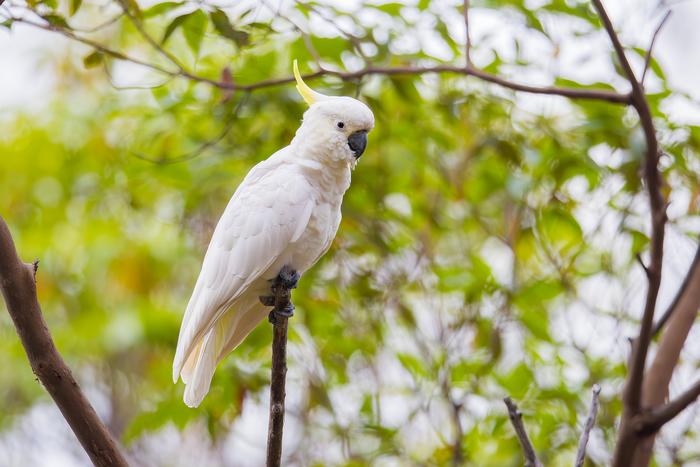
Ecologists at the University of Hong Kong (HKU) have unveiled groundbreaking discoveries that promise to reshape conservation strategies for two prominent cockatoo species: the Sulphur-crested Cockatoo and the critically endangered Yellow-crested Cockatoo. These species, particularly the Yellow-crested Cockatoo, whose wild population dwindles to around 2,000 individuals, have faced increasing threats from habitat destruction and illegal trapping, necessitating an urgent response from the scientific community.
Historically, the classification of these cockatoos relied heavily on subtle physical traits, a practice that has now been challenged through genomic research. For the first time, whole-genome analysis has been applied to both species, resulting in vital genetic insights that could provide a pathway to more informed conservation measures. This transformative research has been documented in prestigious journals, including Molecular Biology and Evolution and Molecular Ecology, marking a significant advancement in the field of avian conservation genetics.
In a pivotal study published in Molecular Biology and Evolution, researchers have laid to rest a century-old assertion claiming that the Triton Cockatoo and the Sulphur-crested Cockatoo are merely variations of a single species. By employing sophisticated genomic techniques, the study has reaffirmed the Triton Cockatoo as a distinct species inhabiting most of New Guinea, contrary to the previous belief that it was synonymous with the Sulphur-crested Cockatoo, which is now understood to inhabit only Australia and a limited southern region of New Guinea.
This newfound distinction carries crucial implications for conservation projects, particularly in New Guinea, where the two species coexist. Ongoing initiatives led by the Indonesian government, aimed at reintroducing displaced pet birds back into their native habitats, are now under scrutiny. Dr. Arthur Sands, a leading expert in cockatoo research, emphasizes that misidentifying or improperly managing reintroduction programs could undermine the long-term survival of these birds. Incorrect introductions may lead to hybridization, which threatens to compromise the genetic integrity of both species and disrupt ecological balances within their habitats.
Moreover, the second study focused directly on the Yellow-crested Cockatoo, leveraging DNA extracted from century-old museum specimens. This innovative approach, termed “museomics,” serves as an invaluable tool for examining the genetic diversity of endangered species while minimizing additional stress on populations in the wild. The analysis revealed three genetically distinct groups within the Yellow-crested Cockatoo populations found in the Wallacea region, an area notable for its rich biodiversity.
Interestingly, the research also suggests that the previously identified subspecies may not have the distinctiveness once thought. There are compelling questions regarding the path taken by the isolated C. s. abbotti population to a remote Indonesian island, raising curiosity due to the cockatoos’ non-migratory nature. This shift in understanding the genetic diversity of the Yellow-crested Cockatoo prompts a reevaluation of the species’ evolutionary trajectory, requiring updated conservation strategies.
Dr. Astrid Andersson, who led the study in Molecular Ecology, pointed out the advantages of museomics by providing genetic information for species that are either rare, endangered, or, in some cases, extinct. The insights gained from these historic specimens can guide critical conservation initiatives, such as genetic rescue. Enhancing the genetic diversity of endangered species through carefully planned breeding programs could significantly mitigate the risks posed by extinction.
Professor Juha Merilä, leading the research group, further reinforced the notion that precise identification of evolutionarily significant units is fundamental for effective conservation management. The research conducted at HKU underscores the necessity of integrating genetic data into strategic planning, thus creating a roadmap for safeguarding not only cockatoos but also other endangered species facing similar threats worldwide.
As this research unfolds, it sets the stage for a more nuanced understanding of avian biology and conservation methodologies. The findings pave the way for enhanced policies and practices that protect not just the cockatoos but also their fragile ecosystems, where many creatures depend on the survival of these emblematic species for their own existence.
These groundbreaking studies will influence conservation practices and legislative efforts, prompting a need for updates in global protective frameworks such as CITES. Recognizing the Triton Cockatoo as a separate species necessitates increased protective measures, reflecting an evolving understanding of biodiversity and its intricate layers.
Going forward, conservationists will need to harness these genetic insights to bolster efforts against the threats of climate change, habitat loss, and illegal sourcing. Only with a robust understanding of each species’ unique genetic landscape can conservationists hope to implement strategies that successfully mitigate extinction risks.
The implications of this research extend beyond cockatoos; it highlights a broader need for genetic literacy within conservation. As researchers collaborate across disciplines, they are likely to uncover further discoveries that challenge existing paradigms and drive forward-thinking conservation initiatives.
In conclusion, the breakthroughs achieved by HKU ecologists demonstrate the critical role that genomic research can play in avian conservation. By delving deeper into the genetic intricacies of these iconic birds, researchers are poised to better inform and implement conservation measures that could ultimately secure the future of both the Sulphur-crested and Yellow-crested Cockatoos.
Subject of Research: Genetics and Conservation of Cockatoos
Article Title: Genetic Insights into the Conservation of the Sulphur-crested and Yellow-crested Cockatoos
News Publication Date: October 2023
Web References: [To be filled based on journal links]
References: [To be filled based on research papers]
Image Credits: Matthew Kwan
Keywords: Cockatoo Conservation, Genomic Research, Endangered Species, Avian Biology, Habitat Loss, Biodiversity.





